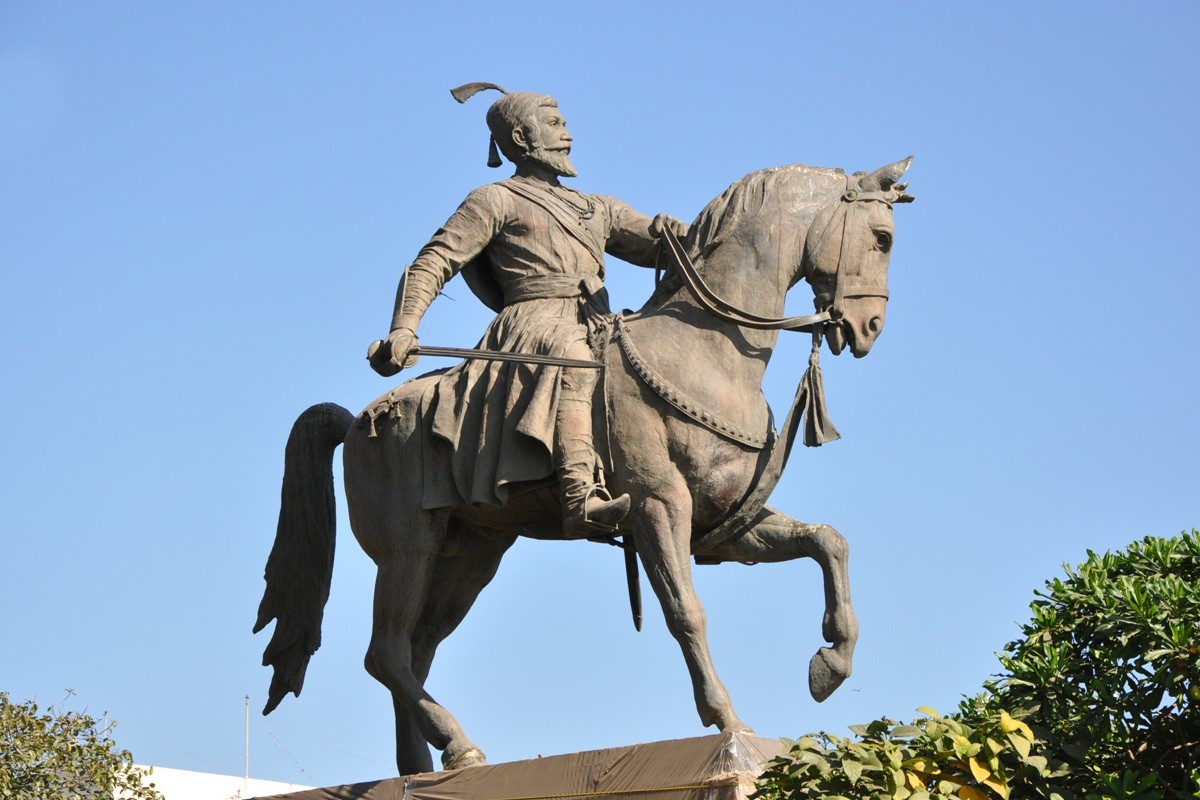Chattrapati Shahu Maharaj of Kolhapur proposes the idea of a Shivaji Memorial Hall in Pune
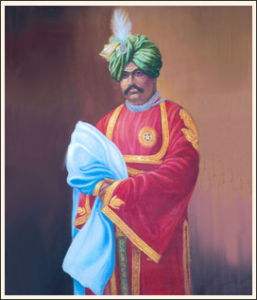
After the Peshwas lost to the British at the Battle of Koregaon (just outside of Pune) in January 1818, signalling the end of the Mahratta Empire, the British signed treaties with the Maharajas of Kolhapur (Shahu), Baroda (Gaekwar), Indore (Holkar), and Gwalior (Scindia). In 1917, as no memorial existed for Shivaji at that time, Chattrapati Shahu Maharaja of Kolhapur mooted an idea to develop a memorial for Shivaji Maharaj that included an equestrian statute and a memorial hall honoring the Great Mahratta king. All the Mahratta chiefs contributed financially to the effort, including the smaller states of Dewas and Dhar (Pawar/Puar).
Prince of Wales lays the Foundation Stone
As Chattrapati Shahu Maharaj also wanted support from the British, he prevailed upon the Governor General of India to invite the Prince of Wales to lay the foundation stone for the ambitious project. The British colonial rulers had come to accept Indian nationalism by supporting activities that potrayed them as progressive rulers who supported education of “natives”.On November 19, 1921, Prince of Wales arrived in Poona (now Pune) by train and was escorted by a parade of Gwalior and Kolhpur Lancers, along with elephants, camels and horses to the the site in Bhamburda (now Shivajinagar) to lay the foundation stone. In an effort to appease Indian nationalism, he spoke of Shivaji as “one of the great Indian soldiers and statesman and founder of the Mahratta greatness who not only founded an Empire, but built a nation.”
The committee led by the Shahu Maharaj commenced the project by hiring two sculptors – Ganpatrao Mhatre for the statue and Nanasaheb Karmarkar for the panels. Shahu Maharaj died in May 1922 before his dream of the memorial was realized. Maharaja of Gwalior, Alija Bahadur Madho Rao Scindiacontinued to lead the effort till he died in June 1925. Rajaram Maharaj of Kolhapur, son of Shahu Maharaj took over with an ambitious goal of finishing the statue by 16 June 1928 (in three years) to coincide with the three hundred years birth anniversary of Shivaji.
The Sculptors and their approach
Raosaheb Ganaptrao Mhatre was a well-known established sculptor who had completed many projects all over India. His clients included the Maharajas of Mysore, Baroda, Kolhapur and several rich Parsee businessmen. His sculpture of the Persian poet Firdawsi commisioned by the Parsees of Bombay adorns the entrance of Tehran University. In 1896, while at the Sir J J School of Arts hewas awarded the Victoria Medal for Sculpture and Mayo Medal for excellence in painting. As a young student, he sculpted a life size figure of a young Maharashtrian girl draped in a traditional nine yard sari on her way to worship, in Plaster of Paris, titled“Mandir path gamini (To the Temple)”. This masterpiece adorns the entrance of the Sir J J School of Arts.
Nanasaheb Karmarkar was discovered by Otto Rothfeld a colonial British civil servant who had seen young Karmarkar’s worksmanship in his hometown Sasavane(near Alibag). He got Karmarkar admitted into the Sir J J School of Arts in Bombay. Karmarkar was a student of Ganpatrao Mhatre who was a visiting faculty at Sir J J School of Arts.Karmarkar graduated with the top rank and found work in Mumbai and Calcutta sculpting statues of famous personalities and Indian dieties. He was orginally commissioned by the Shivaji Memorial Hall Committee to do the panels for the statute.Mhatre’s approach was to make the statue with piece meal sand casting technique whichtook more time but allowed for a better finish. Karmarkar’s approach was to do a one piece cast that was more risky but took less time. His art is on display at his home (converted into a Museum) at Sasavane near Alibag.
A competition and race to finish
Rajaram Maharaj of Kolhapur had used Karmarkar for other projects and was impressed with the panels that he had produced for Shivaji Memorial projectthree months before the deadline given to him. Mhatre’s work had not progressed much. Frustrated by slow progress made by Mhatre, he authorised Karmarkar to make another statute for the project. Now both sculptors had a hard deadline to meet.
Mazagon Docks Bombay from Building Ships to Statues
As there was no studio or foundry in India that could build a 13.5 feet statute which would translate into a 15-20 tonne statue, Karmarkar approached Mazagon Docks that had the capacity to cast such an undertaking in their foundry. The English foreman Rasmussen hedged by saying that he had never done such a project, but would give it his best effort. With that assurance, Karmakar built the sand cast that would be used by Mazagon Docks. The statue was finally cast on the night of June 1, 1928 by a team of mostly Chinese workers pouring molten bronze to create a single piece casting.
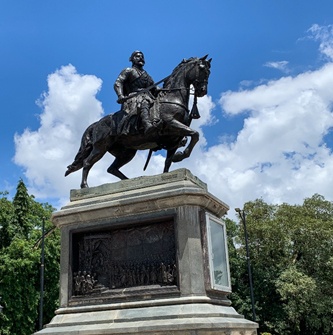

The Side Panels sculpted by Nanasaheb Karmarkar

Side Panels – from Left to Right and Top to Bottom
Top
Battle of Wani-Dindori – between Daud Khan of the Mughals and Shivaji maharaj at Wani-Dindori (near Nashik).
Coronation Ceremony of Chhatrapati Shivaji Maharaj performed by Gaga Bhatt, of Varanasi .
Bottom
“Kalyan Khajina” at the rear of the pedestal, depicting the story of the raid on Mulla Ahmed (the Mughal Subedar of Kalyan), whose daughter-in-law is captured along with treasures. Instead of keeping her as spoils of war, Shivaji Maharaj offers her safe passage to her home in Bijapur.
Goddess Bhavani in marble atthe front of the pedestal, depicting Shivaji seeking blessings of Bhavani Mata.
The Journey from Wadala to Bhamburda (now Shivajinagar)
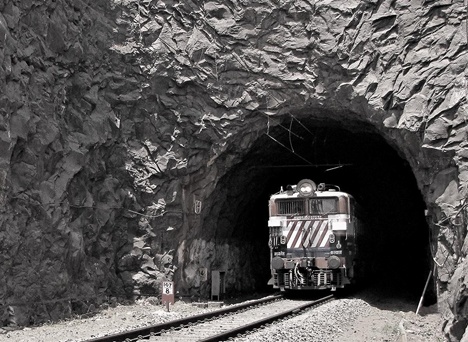
As a part of his contract, Karmarkar was also tasked with bringing the statue from Mazagon Docks to the site at Bhamburda (now Shivajinagar). Various options were explored including sending it by sea via Ratnagiri and then by road to Pune via Kolhapur to avoid the winding ghats. While the sea route was feasible it would not have made the hard deadline that was in place. With packing materials, the longest dimensions had reached 15 ft. Technical help of GIP (Great Indian Peninsula) railway engineers was sought to find a solution. The smallest tunnel had a maximum clearance of 9.5 feet. The GIP engineers decided to load the statue without packing at an angle so that it would clear the smallest tunnel.
Ceremonial Unveiling of the Shivaji Statute June 1928
The statue was unveiled by the then Governor of Bombay, Sir Leslie Wilson on June 16, 1928. The event can be seen on the following British Pathe Youtube video, with all the royal splendor and parade of elephants, camels and horses.
Epilogue
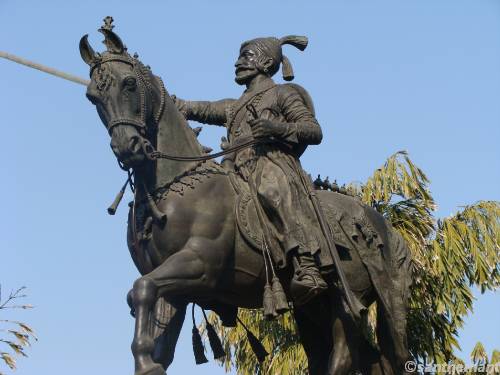
While Nanasaheb Karmakar won the competition, it put Raobahadur Ganpatrao Mhatre into serious financial trouble. Luckily, Maharaja Sayaji Rao III of Baroda came to the rescue and bought the other statue and had it installed in the city center in Baroda. The construction of the Shivaji Memorial Hall was completed in 1933 and inaugurated by H.E Sir Fredrick Sykes, the Governor of Bombay on Sept 20, 1933. It serves as the main building of the Shri Shivaji Preparatory Military School. During World War II, many graduating students were offered direct commission in the Royal Indian Army, to aid the British war efforts.
Arun Mantri is an alumnus of Shri Shivaji Military Preparatory School and a descendent of NaroramShenvi-Rege alias Naroram Mantri of Bagni/Islampur, who was a Sardar Mantri (minister) in the cabinet of ChattrapatiShahu Maharaj of Kolhapur. Naroram Mantri also built the famous ShantaDurga Temple in Kavlem, Goa. The story is compiled from various sources.



